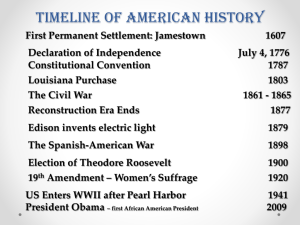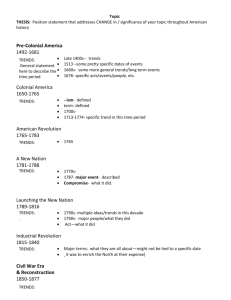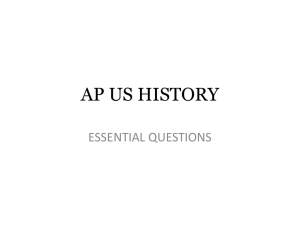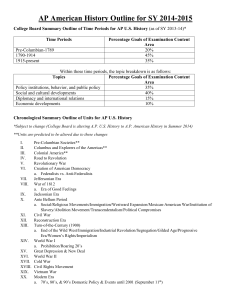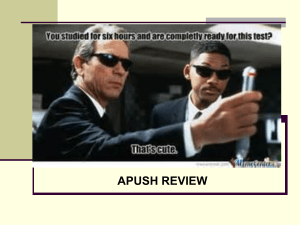MADISON PUBLIC SCHOOL DISTRICT United States History I Enriched Authored by
advertisement
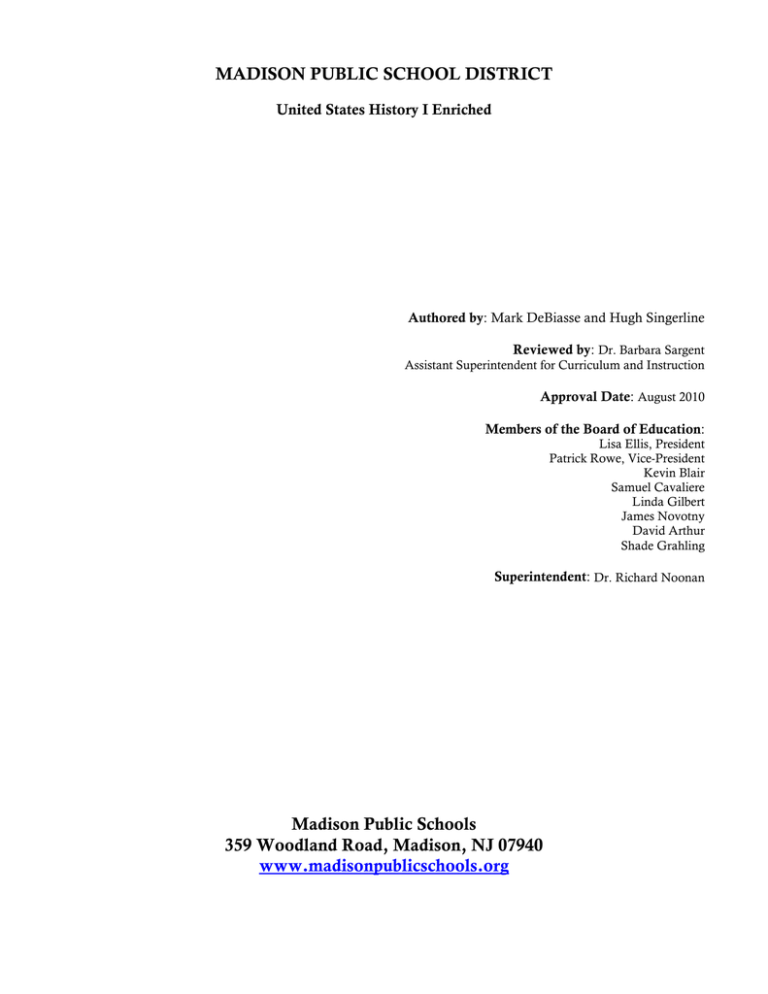
MADISON PUBLIC SCHOOL DISTRICT United States History I Enriched Authored by: Mark DeBiasse and Hugh Singerline Reviewed by: Dr. Barbara Sargent Assistant Superintendent for Curriculum and Instruction Approval Date: August 2010 Members of the Board of Education: Lisa Ellis, President Patrick Rowe, Vice-President Kevin Blair Samuel Cavaliere Linda Gilbert James Novotny David Arthur Shade Grahling Superintendent: Dr. Richard Noonan Madison Public Schools 359 Woodland Road, Madison, NJ 07940 www.madisonpublicschools.org I. OVERVIEW This 10th grade social studies curriculum focuses on the earlier periods in American history, beginning with the French and Indian War, and ending with the Populist movement of the 1890s. Intended to encourage students to develop their research, analytical, critical thinking, and communication skills, the course employs a thematic approach. With the goal of emphasizing the understanding of complex issues, each unit of study will provide opportunities for students to explore the makeup of the American people; the evolution of their economic and technological systems; the relationships with other countries that shaped their world; the development of their political institutions; and the changes in their society. US I Enriched is a year long course, the second in a three year sequence of college bound courses that is intended to help students develop the skills necessary to achieve success in high school studies, and ultimately in their post-graduate pursuits. The Enriched level student works at a faster pace with more complex reading and writing assignments than his/her counterpart in US I. II. RATIONALE The United States History I Enriched curriculum is meant to encourage the development of essential skills as well as increase student mastery and retention of historical knowledge, with the larger purpose of enabling students to better participate as global citizens in a nation that has evolved over the course of time. Successful completion of this course will allow for greater awareness of the culture, economics, politics, culture, and ideas of the United States, and provide a solid foundation for the United States History II Enriched course. III. STUDENT OUTCOMES (Core Curriculum Standards) Standard 6.1 (U.S. History: America in the World). All students will acquire the knowledge and skills to think analytically about how past and present interactions of people, cultures, and the environment shape the American heritage. Such knowledge and skills enable students to make informed decisions that reflect fundamental rights and core democratic values as productive citizens in local, national, and global communities. Students will: Unit 1: Road to Revolution • Explain how British North American colonies adapted the British governance structure to fit their ideas of individual rights, economic growth, and participatory government. • Explain how economic ideas and the practices of mercantilism and capitalism conflicted during this time period. • Determine the extent to which natural resources, labor systems (i.e., the use of indentured servants, African slaves, and immigrant labor), and entrepreneurship contributed to economic development in the American colonies. • Explain the consequences to Native American groups of the loss of their land and people. • Analyze the intellectual origins of the major ideas expressed in the Declaration of Independence • Analyze contributions and perspectives of African Americans, Native Americans, and women during the American Revolution. Unit 2: Articles of Confederation/Constitution • Evaluate the importance of the Declaration of Independence, the Constitution, and the Bill of Rights to the spread of democracy around the world. • Compare and contrast state constitutions, including New Jersey’s 1776 constitution, with the United States Constitution, and determine their impact on the development of American constitutional government. • Compare and contrast the arguments of Federalists and Anti-Federalists during the ratification debates, and assess their continuing relevance. • Analyze the problems of financing the American Revolutionary War and dealing with wartime inflation and profiteering. Unit 3: New Nation • Explain how judicial review made the Supreme Court an influential branch of government, and assess the continuing impact of the Supreme Court today. • Examine the emergence of early political parties and their views on centralized government and foreign affairs, and compare these positions with those of today’s political parties. • Explain the effects of inflation, debt, and attempts by new state and national governments to rebuild the economy by addressing issues of foreign and internal trade, banking, and taxation. • Relate events in Europe to the development of American trade and American foreign and domestic policies. • Describe how the Supreme Court increased the power of the national government and promoted national economic growth during this era. Unit 4: Jacksonian Era • Analyze how the United States has attempted to account for regional differences while also striving to create an American identity. • Judge the fairness of government treaties, policies, and actions that resulted in Native American migration and removal. • Compare and contrast the successes and failures of political (i.e., the 1844 State Constitution) and social (i.e., abolition, women’s rights, and temperance) reform movements in New Jersey and the nation during the Antebellum period. • Analyze how technological developments transformed the economy, created international markets, and affected the environment in New Jersey and the nation. • Analyze the role education played in improving economic opportunities and in the development of responsible citizens. • Determine the impact of religious and social movements on the development of American culture, literature, and art. • Analyze how ideas found in key documents (i.e., the Declaration of Independence, the Seneca Falls Declaration of Sentiments and Resolution, the Emancipation Proclamation, and the Gettysburg Address) contributed to demanding equality for all. Unit 5: Antebellum America • Evaluate the effectiveness of the Northwest Ordinance in resolving disputes over Western lands and the expansion of slavery. • Assess the influence of Manifest Destiny on foreign policy during different time periods in American history. • Assess the role of geopolitics in the development of American foreign relations during this period. • Analyze the various rationales provided as a justification for slavery. • Assess the impact of Western settlement on the expansion of United States political boundaries. • Assess how states' rights (i.e., Nullification) and sectional interests influenced party politics and shaped national policies (i.e., the Missouri Compromise and the Compromise of 1850). • Analyze the ways in which prevailing attitudes, socioeconomic factors, and government actions (i.e., the Fugitive Slave Act and Dred Scott Decision) in the North and South (i.e., Secession) led to the Civil War. Unit 6: Civil War and Reconstruction • • • • • • • • • Evaluate how political and military leadership affected the outcome of the Civil War. Judge the effectiveness of the 13th, 14th, and 15th Amendments in obtaining citizenship and equality for African Americans. Use maps and primary sources to assess the impact that geography, improved military strategies, and new modes of transportation had on the outcome of the Civil War. Assess the role that economics played in enabling the North and South to wage war. Compare and contrast the immediate and long-term effects of the Civil War on the economies of the North and South. Compare and contrast the roles of African Americans who lived in Union and Confederate states during the Civil War. Analyze the debate about how to reunite the country, and determine the extent to which enacted Reconstruction policies achieved their goals. Relate conflicting political, economic, social, and sectional perspectives on Reconstruction to the resistance of some Southern individuals and states. Analyze the impact of the Civil War and the 14th Amendment on the development of the country and on the relationship between the national and state governments. Unit 7: The West • Determine how expansion created opportunities for some and hardships for others by considering multiple perspectives. • Analyze the impact of population shifts and migration patterns during the Reconstruction period. • Explain how the Homestead Act, the availability of land and natural resources, and the development of transcontinental railroads and waterways promoted the growth of a nationwide economy and the movement of populations. • Compare and contrast economic development of the North, South, and West in the post-Civil War period. Unit 8: The Gilded Age • Explain how immigration intensified ethnic and cultural conflicts and complicated the forging of a national identity. • Relate industrial growth to the need for social and governmental reforms. • Assess the impact of governmental efforts to regulate industrial and financial systems in order to provide economic stability. • Analyze the effectiveness of governmental policies and of actions by groups and individuals to address discrimination against new immigrants, Native Americans, and African Americans. • Assess the impact of rapid urbanization on the environment and on the quality of life in cities. • Analyze the economic practices of various business organizations (i.e., corporations and monopolies) regarding the production and marketing of goods, and explain the positive or negative impact of these practices on the nation and on individuals. • Analyze the cyclical nature of the economy and the impact of periods of expansion and recession on businesses and individuals. • Analyze government policies and other factors that promoted innovation, entrepreneurship, and industrialization in New Jersey and the United States during this period. • Relate varying immigrants’ experiences to gender, race, ethnicity, or occupation. • Determine how supply and demand influenced price and output during the Industrial Revolution. IV. THEMATIC STRANDS FOR UNITED STATES HISTORY CURRICULUM Theme 1: The Peopling of the United States Focus Question: How did the United States become a multiracial/multicultural society? • • • • What is an American? What factors contributed to ethnic and racial diversity within the United States? How have Americans responded to the challenges of living in a diverse society? How has cultural diversity contributed to the development of the United States economy? Theme 2: Technology, Environment, and the Economy of the United States Focus Question: How did the United States evolve economically? • How has the availability of natural resources impacted American economic thought? • How important have economic considerations been in the development of American political life? • What has been the relationship between a capitalist economic system and a democratic political system in the American system? • To what extent have the emphases on equality and success been mutually achievable? Theme 3: The United States and the World Focus Question: How have relations with foreign nations shaped the history of the United States? • To what extent has American involvement in the world reflected domestic concerns? • What tensions have emerged due to economic and political influences in American foreign policy? • How and why have American wars resulted from desire or need? • To what degree has American foreign policy been determined by national ideals/ Theme 4: An Evolving Democracy Focus Question: How has the government of the United States changed? • How have particular understandings of human nature affected American democratic development? • How has the tension between community and individual been addressed over time? • To what extent have the Declaration of Independence and the Constitution remained relevant? • Why and in what manner has the relationship between the individual and the government changed over time? • To what degree has the American political system evolved toward fulfillment of the principles embodied in the nation's founding documents? Theme 5: Social Change Focus Question: How did individuals or groups initiate change in American life? • Why have some groups needed to fight for their rights? • What methods have been used to achieve social change? • In what ways have the goals of different groups been related? • To what extent have individual and group demands affected American politics and traditions? V. ESSENTIAL QUESTIONS AND CONTENT (Note: Each content objective is linked in turn to one of the five thematic strands) Unit 1: Road to Revolution (French and Indian War through the American Revolution, 1754-1783) • Explain how the system of Indentured Servitude and the enslavement of Africans contributed to the economic and socio-cultural development of early America. • • • • Analyze how the ideas and practices of mercantilism defined economic relations between Great Britain and her North American colonies. Analyze how the French and Indian War altered the relationship between Great Britain and her North American colonies. Explain how the American colonists used political institutions and democratic practices to resist British authority in the period leading up to the American Revolution. Assess the degree to which revolutionary ideals and rhetoric transformed the social structure and dynamics of the British colonies. Unit 2: Founding Era (Articles of Confederation/Constitution 1781-1791) • Evaluate impact of demographic trends and conditions on political events and decision-making in the early republic. • Explain how economic developments in post-revolutionary America contributed to political instability and the formation of a new constitutional order. • Assess the impact that foreign nations had on American sovereignty and national security. • Trace the evolution of American government in terms of the distribution of political power and adherence to republican ideals and individual rights. • Evaluate the impact of revolutionary ideology on the rights of women and minority groups in the early republic. Unit 3: New Nation (Washington Administration Through the War of 1812) • Assess the impact of early expansionism and immigration trends on the cultural complexion of the new nation. • Analyze the dynamic relationship between government policy, technological innovation and competing visions of American economic development during the founding era. • Evaluate the effectiveness of American foreign policy in dealing with the international challenges presented by the Napoleonic era. • Explain how government practice shaped our understanding of the constitution and the power of American political institutions. • Explore the diverse experiences of African-Americans living in various parts of the nation during the early years of the American republic. Unit 4: Jacksonian Era (Era of Good Feelings through Jacksonian Democracy, 1815-1844) • Evaluate the extent to which members of minority groups (African-Americans, women and Native Americans) shared in the benefits afforded the "common man" during the Jacksonian era. • Assess the scope and character of American economic development during the Jacksonian era. • Explore the emergence of a distinct American culture as evidenced by foreign observations of American life during the Jacksonian era. • Assess the impact of political developments during the Jacksonian era on the American constitutional and electoral systems. • Evaluate the effectiveness of reform movements during the Jacksonian era in dealing with the emerging social and economic problems of the early industrial era. Unit 5: Antebellum America (Industrial and Transportation Revolutions to the Civil War, 1830s-1860) • Analyze the forces behind and consequences of wide scale immigration and internal migration on the peopling of the West. • Evaluate the relationship between technological innovation and the development of regional economic and transportation systems. • Assess the impact of Manifest Destiny on relations with neighboring powers and indigenous populations. • Explore the constitutional issues raised by westward expansion and the spread of slavery. • Trace the polarization of American society on the slavery question and examine the various practical and philosophical responses among social groups of the antebellum period. Unit 6: Civil War and Reconstruction (Election of Lincoln to the Election of Hayes, 1860-1877) • Explore the demographics of participation in the Civil War. • Assess the impact of economic and technological conditions on the nature and outcome of the Civil War. • Examine the conduct and effectiveness of foreign diplomacy carried out by Union and Confederate governments during the Civil War. • Analyze the constitutional and political tensions that emerged as a result of the Civil War and Reconstruction. • Evaluate the success of Reconstruction with regard to the rights and social standing of AfricanAmericans. Unit 7: The West (Homestead Act and Transcontinental Railroad to Fredrick Jackson Turner, 1862-1900) • Analyze the destructive effects of westward settlement on the Native Americans of the Great Plains. • Assess the contribution of the West to the development of an emerging national economy. • Examine to what extent the West emerged as a region of opportunity for immigrants from various parts of the globe. • Explore the emergence of populism in West as a response to the emerging power of a consolidated railroad industry. • Evaluate the impact of westward settlement on gender and race relations. Unit 8: The Gilded Age (Modern Industrialism to Labor Unrest, 1865-1900) • Explore the impact of wide scale European immigration on the cultural fabric of the United States. • Examine the scope and methods of modern industrial America and their impact on social conditions and workplace life. • Assess the impact of modern industrialism on the emergence of foreign markets and American foreign policy. • Evaluate the ability of the American political system to promote prosperity and regulate increasingly large and powerful business enterprises. • Assess the range and effectiveness of the response of labor to the rise of industrial America. VI. STRATEGIES The US History I Enriched curriculum will employ a "depth over breadth" approach in which topics of enduring interest will be pursued thematically and in greater detail through a variety of methods, including: • • • • • • • • • • • • Cooperative learning groups Teacher presentation Film Guided Reading Student research projects Primary source analysis Role play simulation Individual and group presentations Think, Pair and Share Discussion (class and graded) Geographic analysis Debate Particular emphasis will be given to reading, interpreting and analyzing a variety of primary source materials. Activities will target a variety of learning styles. They will be structured to enable students to read comprehensively, communicate analytically, and think systematically about how the past interactions of individuals and groups have shaped the American experience. VII. EVALUATION Assessment of student mastery of the material will take a variety of forms. Assessments will be both formative and summative in design and will be keyed to the thematic strands and essential questions for each unit. There will be an emphasis on measuring student ability to read, interpret and analyze a variety of primary source materials. The objective section of the midterm and final exams will assess student mastery of the key concepts and terms found in the curriculum Scope and Sequence. Each exam will also contain a freeresponse section to be developed in collaboration with department colleagues. This portion of the examination will involve reading, interpreting and analyzing a variety of primary source materials and applying them to a related prompt. VIII. REQUIRED RESOURCES Textbook: Danzer, "The Americans" (1998) Teachers will supplement the assigned textbook with a variety of materials such as PowerPoint presentations, primary and secondary sources, film and video clips, educational websites and media center databases. Supplementary Materials: (Partial Listing) PowerPoint Presentations found on www.historyteacher.net Online streaming videos at: www.pbs.org and www.cjims.org Supreme Court Cases http://www.streetlaw.org/en/landmark.aspx Digital History http://www.digitalhistory.uh.edu/timeline/timelineN.cfm Original Documents and Primary Sources http://avalon.law.yale.edu/ http://www.gilderlehrman.org/ Excerpts of the following films may be shown to enhance student understanding of the material: • • • • • • • • "The Last of the Mohicans" (Unit 1) "Roots" (Unit 4) "Amistad" (Unit 5) "Glory" (Unit 6) "Birth of a Nation (Unit 6) "Dances With Wolves" (Unit 7) "Shane" (Unit 7) "Red River" (Unit 7) IX. SCOPE AND SEQUENCE (Note: Chapter references are intended as a general guide to where information relevant to the key concepts and terms can be located). Unit 0: Understanding Our Themes (1 Week) Unit 1: Road to Revolution (3 weeks) Danzer, Chapters 3 & 4 • Mercantilism and salutary neglect • Triangular trade and Middle Passage • Indentured servitude • French and Indian War and Treaty of Paris (1763) • Parliamentary acts (1763-1774) • Colonial resistance measures • Lexington and Concord • Continental Congresses and Declaration of Independence • Patriots and Loyalists • New York/New Jersey campaign of 1776 • Battle of Saratoga and French alliance • Battle of Yorktown and Treaty of Paris (1783) • Minorities in the Revolution Unit 2: Articles of Confederation/Constitution (5 weeks) Danzer, Chapter 5 • Articles of Confederation/state constitutions • Post-Revolution economy/Shays' Rebellion • Land Ordinances (1785 and 1787) • Successes and failures of the Articles of Confederation • Constitutional (Philadelphia) Convention (federalism, separation of powers, checks and balances) • Ratification debate/Bill of Rights Unit 3: New Nation (5 weeks) Danzer, Chapter 6 • Hamilton's economic plan and Whiskey Rebellion • Strict v. loose constructionism • Partisan politics • Neutrality proclamation • Jay's Treaty/Pinckney's Treaty • XYZ Affair and Alien and Sedition Acts • Virginia and Kentucky resolutions • Midnight judges • Election of 1800 • Louisiana Purchase and Lewis and Clark expedition • Marshall Court • Impressment/Embargo Act • War hawks • War of 1812 Unit 4: Jacksonian Era (5 weeks) Danzer, Chapter 7 & 8 • Era of Good Feelings • American System • Elections of 1824 and 1828 • Early industrial revolution (mass production, interchangeable parts, local developments) • Factory labor/slave labor • • • • • • • • • Indian Removal Act/Trail of Tears Political rise of the "common man" King Andrew/rise of the Whigs Reform movements (including women's rights, but see Unit 5 for abolitionism) Tariff of Abomination/nullification Jackson and the National Bank Specie Circular and Panic of 1837 Maysville Road veto De Tocqueville MIDTERM EXAM Unit 5: Antebellum America (5 weeks) Danzer, Chapters 7 - 10 • Monroe Doctrine • Manifest destiny • National Road, Erie Canal, B&O Railroad, Oregon Trail • Lords of the Lash and Lords of the Loom • Technological innovations (telegraph, steel plow and reaper, sewing machine) • German and Irish immigration/nativism • Expansion and conflict (Texas Annexation, Oregon dispute, Mexican War) • Native Americans (Black Hawk War, Fort Laramie Treaty) • Gold Rush • Slavery and the Constitution (Missouri Compromise, Wilmot Proviso, gag rule, Compromise of 1850, Kansas-Nebraska Act, Dred Scott ruling, Lincoln-Douglas debates) • Responses to the slavery question (slave rebellions, abolitionism, Bleeding Kansas, John Brown, Underground Railroad, personal liberty laws) • Impact of slavery on party politics Unit 6: Civil War and Reconstruction (5 weeks) Danzer, Chapters 11 & 12, 16 • Mobilization for war (conscription, draft riots, African Americans, women) • Strategy, diplomacy, and balance of forces • Constitutional and political issues (habeas corpus, emancipation, Copperheads, Wade-Davis, Reconstruction amendments, Johnson impeachment, Civil Rights Act, Reconstruction Act, Supreme Court rulings, redemption, Compromise of 1877) • African Americans (Freedmen's Bureau, sharecropping, black codes, Ku Klux Klan, Plessy v. Ferguson, Exodusters) Unit 7: The West (4 weeks) Danzer, Chapters 13 & 16 • Native Americans (Sand Creek, Red River War, George Custer, Dawes Act, Wounded Knee) • Cattle Kingdom (Sod-busters v. ranchers, cowboy culture) • Mining • Transcontinental Railroad • Demographics of Western settlement • Mail-order catalogs • Interstate Commerce Act/ICC/Munn v. Illinois • Monetary policy and Panic of 1893 • Grange movement/Populism/Cross of Gold speech Unit 8: The Gilded Age (5 weeks) Danzer, Chapters 14 - 16 • Second Wave immigration (Ellis Island, Angel Island, Chinese Exclusion Act) • Political machines (Tammany Hall/Tweed Ring, Thomas Nast) • Urbanization (problems, settlement house movement, Social Gospel, Jacob Riis) • Vertical and horizontal integration • New industries (oil, steel, railroads) • Gilded Age philosophies (social Darwinism, Gospel of Wealth, robber barons v. captains of industry) • Overseas investments and enterprise • Pendleton Act/civil service reform • Sherman Anti-trust Act • Labor unions (Knights of Labor, AFL, IWW, Haymarket, Pullman strike, Samuel Gompers, Eugene Debs, Mother Jones) FINAL EXAM
